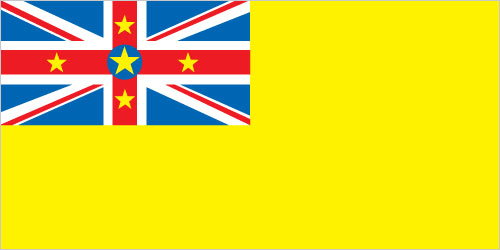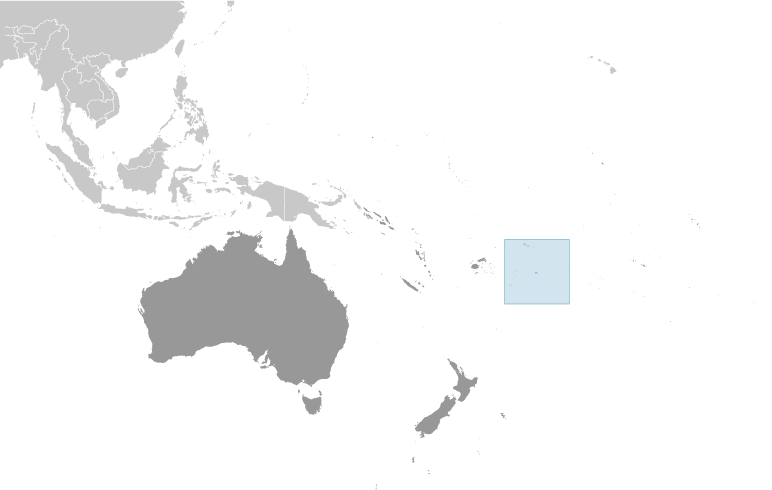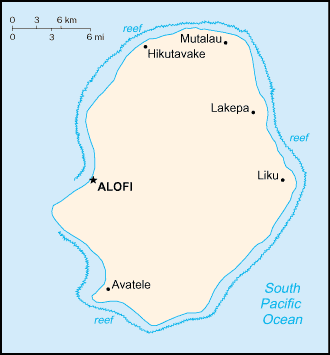



Australia-Oceania :: NIUE
Introduction :: NIUE
-
Niue's remoteness, as well as cultural and linguistic differences between its Polynesian inhabitants and those of the adjacent Cook Islands, has caused it to be separately administered by New Zealand. The population of the island continues to drop (from a peak of 5,200 in 1966 to an estimated 1,229 in 2013) with substantial emigration to New Zealand 2,400 km to the southwest.
Geography :: NIUE
-
Oceania, island in the South Pacific Ocean, east of Tonga19 02 S, 169 52 WOceaniatotal: 260 sq kmland: 260 sq kmwater: 0 sq kmcountry comparison to the world: 2131.5 times the size of Washington, DC0 km64 kmterritorial sea: 12 nmexclusive economic zone: 200 nmtropical; modified by southeast trade windssteep limestone cliffs along coast, central plateaulowest point: Pacific Ocean 0 mhighest point: unnamed elevation near Mutalau settlement 68 mfish, arable landagricultural land: 19.1%arable land 3.8%; permanent crops 11.5%; permanent pasture 3.8%forest: 71.2%other: 9.7% (2011 est.)NAtyphoonsincreasing attention to conservationist practices to counter loss of soil fertility from traditional slash and burn agricultureparty to: Biodiversity, Climate Change, Climate Change-Kyoto Protocol, Desertification, Law of the Sea, Ozone Layer Protectionone of world's largest coral islands
People and Society :: NIUE
-
noun: Niuean(s)adjective: NiueanNiuen 66.5%, part-Niuen 13.4%, non-Niuen 20.1% (includes 12% European and Asian and 8% Pacific Islanders) (2011 est.)Niuean (official) 46% (a Polynesian language closely related to Tongan and Samoan), Niuean and English 32%, English (official) 11%, Niuean and others 5%, other 6% (2011 est.)Ekalesia Niue (Congregational Christian Church of Niue - a Protestant church founded by missionaries from the London Missionary Society) 67%, other Protestant 3% (includes Seventh Day Adventist 1%, Presbyterian 1%, and Methodist 1%), Mormon 10%, Roman Catholic 10%, Jehovah's Witnesses 2%, other 6%, none 2% (2011 est.)1,190 (July 2014 est.)country comparison to the world: 235-0.03% (2014 est.)country comparison to the world: 201urban population: 42.5% of total population (2015)rate of urbanization: -0.94% annual rate of change (2010-15 est.)ALOFI (capital) 1,000 (2014)NAtotal: NAmale: NAfemale: NAtotal population: NAmale: NAfemale: NANA7.1% of GDP (2013)country comparison to the world: 873 physicians/1,000 population (2008)improved:urban: 98.4% of populationrural: 98.6% of populationtotal: 98.5% of populationunimproved:urban: 1.6% of populationrural: 1.4% of populationtotal: 1.5% of population (2015 est.)improved:urban: 100% of populationrural: 100% of populationtotal: 100% of populationunimproved:urban: 0% of populationrural: 0% of populationtotal: 0% of population (2015 est.)NANANA42.5% (2014)NAtotal: 13 yearsmale: 12 yearsfemale: 15 years (2005)
Government :: NIUE
-
conventional long form: noneconventional short form: Niuenote: pronunciation falls between nyu-way and new-way, but not like new-weeformer: Savage Islandself-governing in free association with New Zealand since 1974; Niue fully responsible for internal affairs; New Zealand retains responsibility for external affairs and defense; however, these responsibilities confer no rights of control and are only exercised at the request of the Government of Niueself-governing parliamentary democracyname: Alofigeographic coordinates: 19 01 S, 169 55 Wtime difference: UTC-11 (6 hours behind Washington, DC, during Standard Time)none; note - there are no first-order administrative divisions as defined by the US Government, but there are 14 villages at the second order19 October 1974 (Niue became a self-governing parliamentary government in free association with New Zealand)Waitangi Day (Treaty of Waitangi established British sovereignty over New Zealand), 6 February (1840)several previous (New Zealand colonial statutes); latest 19 October 1974 (Niue Constitution Act 1974); amended 1992, 2007 (2007)English common law18 years of age; universalchief of state: Queen ELIZABETH II (since 6 February 1952); represented by Governor General of New Zealand Lt. Gen. Sir Jerry MATEPARAE (since 31 August 2011); the UK and New Zealand are represented by New Zealand High Commissioner Mark BLUMSKY (since September 2011)head of government: Premier Toke TALAGI (since 18 June 2008)cabinet: Cabinet chosen by the premierelections/appointments: the monarchy is hereditary; premier indirectly elected by the Legislative Assembly for a 3-year term; election last held on 24 April 2014 (next to be held in 2017)election results: Toke TALAGI reelected premier; Legislative Assembly vote - Toke TALAGI (independent) 12, Stanley KALAUNI 8description: unicameral Assembly or Fono Ekepule (20 seats; 14 members directly elected in single-seat constituencies by simple majority vote and 6 directly elected from the National Register or "common roll" by majority vote; members serve 3-year terms)elections: last held on 12 April 2014 (next to be held in 2017)election results: percent of vote by party - NA; seats by party - 20 independentshighest resident court(s): Court of Appeal (consists of the chief justice and up to 3 judges); note - the Judicial Committee of the Privy Council (in London) is the final appeal court beyond the Niue Court of Appealnote - Niue is a participant in the Pacific Judicial Development Program; the program is designed to build governance and the rule of law in 15 Pacific island countriesjudge selection and term of office: Niue chief justice appointed by the governor-general on the advice of the Cabinet and tendered by the premier; other judges appointed by the governor-general on the advice of the Cabinet and tendered by the chief justice and the minister of justice; judges serve until age 68subordinate courts: High CourtAlliance of Independents or AINiue People's Action Party or NPP [Young VIVIAN]NAACP, AOSIS, FAO, IFAD, OPCW, PIF, Sparteca, SPC, UNESCO, UPU, WHO, WIPO, WMOnone (self-governing territory in free association with New Zealand)none (self-governing territory in free association with New Zealand)yellow with the flag of the UK in the upper hoist-side quadrant; the flag of the UK bears five yellow five-pointed stars - a large star on a blue disk in the center and a smaller star on each arm of the bold red cross; the larger star stands for Niue, the smaller stars recall the Southern Cross constellation on the New Zealand flag and symbolize links with that country; yellow represents the bright sunshine of Niue and the warmth and friendship between Niue and New Zealandyellow, five-pointed star; national color: yellowname: "Ko e Iki he Lagi" (The Lord in Heaven)lyrics/music: unknown/unknown, prepared by Sioeli FUSIKATAnote: adopted 1974
Economy :: NIUE
-
The economy suffers from the typical Pacific island problems of geographic isolation, few resources, and a small population. Government expenditures regularly exceed revenues, and the shortfall is made up by critically needed grants from New Zealand that are used to pay wages to public employees. Niue has cut government expenditures by reducing the public service by almost half. The agricultural sector consists mainly of subsistence gardening, although some cash crops are grown for export. Industry consists primarily of small factories to process passion fruit, lime oil, honey, and coconut cream. The sale of postage stamps to foreign collectors is an important source of revenue. The island in recent years has suffered a serious loss of population because of emigration to New Zealand. Efforts to increase GDP include the promotion of tourism and financial services, although the International Banking Repeal Act of 2002 resulted in the termination of all offshore banking licenses. Economic aid allocation from New Zealand in FY13/14 was US$10.1 million. While in the process of rebuilding, Niue has been dependent on foreign aid.$10.01 million (2003 est.)country comparison to the world: 229$10.01 million (2003)6.2% (2003 est.)country comparison to the world: 31$5,800 (2003 est.)country comparison to the world: 161agriculture: 23.5%industry: 26.9%services: 49.5% (2003)coconuts, passion fruit, honey, limes, taro, yams, cassava (manioc, tapioca), sweet potatoes; pigs, poultry, beef cattlehandicrafts, food processingNA%663 (2001)country comparison to the world: 231note: most work on family plantations; paid work exists only in government service, small industry, and the Niue Development Board12% (2001)country comparison to the world: 127NA%lowest 10%: NA%highest 10%: NA%revenues: $15.07 millionexpenditures: $16.33 million (FY04/05)-12.6% of GDP (FY04/05)country comparison to the world: 2071 April - 31 March4% (2005)country comparison to the world: 153$201,400 (2004)country comparison to the world: 219canned coconut cream, copra, honey, vanilla, passion fruit products, pawpaws, root crops, limes, footballs, stamps, handicrafts$9.038 million (2004)country comparison to the world: 222food, live animals, manufactured goods, machinery, fuels, lubricants, chemicals, drugs$418,000 (2002 est.)country comparison to the world: 201New Zealand dollars (NZD) per US dollar -1.206 (2014)1.2187 (2013)1.23 (2012)1.263 (2011)1.3874 (2010)
Energy :: NIUE
-
3 million kWh (2011 est.)country comparison to the world: 2172.79 million kWh (2011 est.)country comparison to the world: 2170 kWh (2013 est.)country comparison to the world: 1760 kWh (2013 est.)country comparison to the world: 1791,000 kW (2011 est.)country comparison to the world: 213100% of total installed capacity (2011 est.)country comparison to the world: 250% of total installed capacity (2011 est.)country comparison to the world: 1490% of total installed capacity (2011 est.)country comparison to the world: 1880% of total installed capacity (2011 est.)country comparison to the world: 2080 bbl/day (2013 est.)country comparison to the world: 2040 bbl/day (2010 est.)country comparison to the world: 1610 bbl/day (2010 est.)country comparison to the world: 1020 bbl (1 January 2014 est.)country comparison to the world: 1710 bbl/day (2010 est.)country comparison to the world: 17920 bbl/day (2013 est.)country comparison to the world: 2110 bbl/day (2010 est.)country comparison to the world: 20222.57 bbl/day (2010 est.)country comparison to the world: 2090 cu m (2012 est.)country comparison to the world: 1720 cu m (2012 est.)country comparison to the world: 1770 cu m (2012 est.)country comparison to the world: 1510 cu m (2012 est.)country comparison to the world: 1050 cu m (1 January 2014 est.)country comparison to the world: 1753,520 Mt (2012 est.)country comparison to the world: 212
Communications :: NIUE
-
domestic: single-line telephone system connects all villages on islandinternational: country code - 683 (2001)1 government-owned TV station with many of the programs supplied by Television New Zealand; 1 government-owned radio station broadcasting in AM and FM (2009)AM 1, FM 1, shortwave 0 (1998)1 (1997).nutotal: 1,100percent of population: 92.4% (2014 est.)country comparison to the world: 213
Transportation :: NIUE
-
1 (2013)country comparison to the world: 228total: 11,524 to 2,437 m: 1 (2012)total: 11,524 to 2,437 m: 1 (2013)total: 120 kmpaved: 120 km (2011)country comparison to the world: 214major seaport(s): Alofi
Military :: NIUE
-
no regular indigenous military forces; Police Forcedefense is the responsibility of New Zealand
Transnational Issues :: NIUE
-
none
